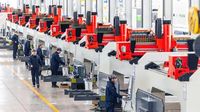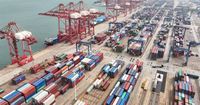Technicians calibrated laser equipment at an industrial park in Ezhou, central China's Hubei Province, on February 8, 2025, as China grapples with the effects of escalating U.S. tariffs on its export-driven economy. The latest wave of tariffs imposed by the Trump administration has seen rates soar to as high as 245 percent on Chinese exports, creating significant challenges for manufacturers who rely heavily on American markets.
In response to these tariff hikes, Chinese exporters are adopting a range of strategies to mitigate risks, leveraging both global supply chain integration and the potential of the domestic market. BEIFA, an office stationery manufacturer based in Ningbo, has projected a remarkable 30 percent increase in its sales to a European retailer this year, despite a slowdown in exports to the U.S. The company, which accounts for over 30 percent of global office stationery exports, has remained optimistic about its future growth.
Zhao Zhongxiu, president of the University of International Business and Economics, emphasized the critical role China plays in the global production system, stating, "The global production system cannot function without China – this is the bedrock of our confidence in countering tariff shocks and navigating trade wars." This sentiment reflects a broader trend among Chinese exporters, demonstrating their resilience amid adversity.
For instance, an automotive parts manufacturer based in Dongguan has shifted its production to Thailand, reducing its reliance on the U.S. market to under 30 percent while expanding sales across 40 countries. This move aligns with China's industrial policy that encourages geographic diversification to minimize vulnerability to unilateral trade actions.
Moreover, the Chinese domestic market is emerging as a crucial lifeline for exporters. Major e-commerce platforms such as JD.com and Alibaba have initiated programs to promote high-quality export goods domestically. JD.com announced a significant commitment to purchase 200 billion yuan (approximately $27.4 billion) worth of products from exporters over the next year, aiming to bolster domestic consumption.
On April 18, 2025, the Commerce Ministry stated that the domestic market offers strong backing for enterprises involved in foreign trade. The ministry's statement came during a meeting attended by Vice Minister Sheng Qiuping, where officials stressed the importance of leveraging China's large market to stabilize foreign trade while expanding domestic consumption.
In a related effort, the Commerce Ministry launched a campaign on April 20, 2025, in Hainan to promote domestic sales of goods originally intended for export. This initiative involves trader groups across various sectors, including mechanical and electrical products, textiles, food, metals, minerals, chemicals, and healthcare. The ministry plans to expand this project into ten provinces, further integrating domestic and export markets.
However, the challenges remain significant. Business confidence and consumer sentiment in China are currently wobbly, with many consumers hesitant to spend due to a weak job market and excess capacity in some industries. This situation has led to fierce price competition, exacerbating deflationary pressures within the economy.
At the Canton Fair, which took place in Guangzhou on April 15, 2025, manufacturers expressed concern over the impact of U.S. tariffs on their operations. Exporters reported a dramatic halt in orders from American clients, with some companies, like Foshan Zero Point Intelligent Electrical Appliance Co., Ltd., which sells 90 percent of its products in the U.S., forced to cease operations temporarily. Sales manager Steven Zhang noted, "We told our suppliers not to deliver raw materials. Our workers were put on leave. There was nothing else we could do."
Similarly, Guangdong Gales Electrical Appliance Co., Ltd. faced a wave of cancellations from U.S. customers, leaving many companies in confusion and uncertainty. Sales manager Monica Liang remarked, "All our [U.S.] customers have stopped their orders. Everyone is waiting. Nobody knows what's going on and we're all confused." This sentiment of uncertainty is echoed across the industry as American businesses also brace for the impact of rising import costs.
Indeed, the Budget Lab at Yale estimated that U.S. households could face a cost increase of nearly $5,000 in the short term due to higher prices on imported goods, including those affected by tariffs. For instance, a washing machine produced in Cixi saw its U.S. retail price surge from $180 to $270 after tariffs were imposed.
Economists predict a significant impact on Chinese economic growth as a result of these tariffs. While Chinese exports to the United States account for only about 15 percent of the country's total exports, the broader economic implications are concerning. Major financial institutions have revised their growth forecasts for China, with Citi reducing its GDP growth prediction to 4.2% from 4.7%, and Goldman Sachs lowering its estimate to 4% from 4.5%.
Despite the challenges, some manufacturers remain hopeful. Zhang Zhengang, a manager at a Tianjin-based bicycle manufacturer, stated, "The impact of the tariffs won't be as big as you'd think. We can exploit the domestic market, the South American market, the European market, as well as Russia and other countries. The global market is huge. There's demand for our products in basically every country." This optimism illustrates the potential for Chinese manufacturers to adapt and thrive in a rapidly changing global landscape.
As the trade conflict between the U.S. and China continues to evolve, the strategies employed by Chinese exporters will be crucial in determining the future of their businesses. The government’s efforts to bolster domestic consumption and the resilience of manufacturers may provide a buffer against the ongoing challenges posed by tariffs and trade tensions.




